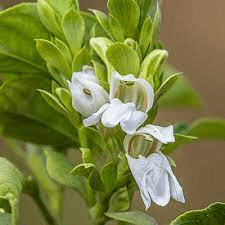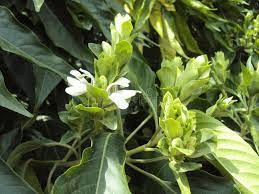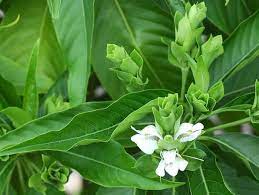Justicia adhatoda, commonly known as Vasaka, is a medicinal plant highly valued for its therapeutic properties in traditional medicine systems. Indigenous to South Asia, Vasaka has been a prominent herb in Ayurveda, Siddha, and Unani practices, where its various parts are utilized for their potential health benefits.
The plant is characterized by its upright stature and lance-shaped leaves. The leaves of Vasaka contain bioactive compounds such as vasicine and vasicinone, which are believed to contribute to its medicinal properties. The herb is particularly renowned for its effectiveness in respiratory conditions.
One of the primary uses of Vasaka is in the management of respiratory disorders. The plant is often employed as an expectorant, helping to alleviate symptoms of coughs, bronchitis, and asthma. Its bronchodilator properties are thought to relax the airways, facilitating easier breathing.
Vasaka is also recognized for its anti-inflammatory and antimicrobial properties. It is employed in traditional medicine to address various infections and inflammations. The plant’s extracts are used in formulations to combat conditions such as fever and skin disorders.
The traditional use of Vasaka extends to its potential as an antispasmodic, making it beneficial in managing conditions related to spasms and muscle contractions. Additionally, it is reputed for its ability to support the digestive system.
Cultivation of Vasaka is undertaken in regions with a tropical climate, and it is often found in the wild as well. The plant is known for its hardiness and adaptability to different soil types.
The Botanical Description of Justicia adhatoda
1. Leaves: Justicia adhatoda, commonly known as Vasaka, boasts lance-shaped leaves with a distinct rough texture. The leaves are arranged opposite each other along the stem, showcasing a vibrant green color.
2. Flowers: The plant produces tubular, white to pinkish flowers in dense clusters. These flowers are characterized by a unique shape, with a tubular structure and a flared, five-lobed tip.
3. Stem: The stem of Justicia adhatoda is woody and erect, contributing to the plant’s overall robust structure. It can reach heights of up to two meters.
4. Fruits: The fruits of Justicia adhatoda are small capsules containing numerous seeds. These capsules mature after the flowering period, contributing to the plant’s reproductive cycle.
5. Root System: Justicia adhatoda has a well-developed root system, providing stability and aiding in nutrient absorption. The roots play a crucial role in the plant’s overall health and longevity.
6. Growth Form: As a shrub, Justicia adhatoda exhibits a compact and bushy growth form. This growth habit makes it suitable for various environmental settings.
7. Bark: The bark of Justicia adhatoda is smooth and brownish-gray. While not a prominent feature, it adds to the overall texture and appearance of the plant.
8. Aromatic Qualities: The leaves of Justicia adhatoda possess a characteristic aromatic scent, which is often described as slightly bitter. This aromatic quality is one of the distinctive features of the plant.
9. Reproductive Features: Justicia adhatoda reproduces through both seeds and vegetative means. The flowers play a crucial role in attracting pollinators, contributing to successful seed production.
10. Medicinal Characteristics: Beyond its ornamental features, Justicia adhatoda is well-known for its medicinal properties. The botanical description aligns with the plant’s traditional uses in various herbal remedies.
The Geographic Distribution of Justicia adhatoda

1. Native Range: Justicia adhatoda is native to the Indian subcontinent, where it thrives in diverse ecosystems ranging from plains to hillsides. It is commonly found in countries like India, Nepal, and Sri Lanka.
2. Altitude Preference: The plant exhibits adaptability to various altitudes, from lower elevations to higher hilly regions. This versatility contributes to its wide geographic distribution.
3. Habitat Types: Justicia adhatoda is found in a range of habitats, including open forests, grasslands, and along riverbanks. It adapts to different soil types and moisture conditions.
4. Climate Conditions: Thriving in tropical and subtropical climates, Justicia adhatoda prefers warm temperatures. It is well-suited to regions with distinct wet and dry seasons.
5. Spread to Other Regions: Due to its medicinal and ornamental value, Justicia adhatoda has been introduced and cultivated in various parts of the world outside its native range. This intentional spread has contributed to its presence in regions beyond South Asia.
6. Invasive Characteristics: While cultivated intentionally, there have been instances where Justicia adhatoda exhibits invasive characteristics in non-native regions. This highlights the importance of responsible cultivation and management.
7. Human Influence: Human activities, including cultivation and herbal medicine practices, have played a role in the plant’s distribution. The intentional cultivation for medicinal purposes has led to its presence in many tropical and subtropical areas.
8. Biotic Interactions: Justicia adhatoda interacts with various biotic factors, including insects and birds that serve as pollinators. These interactions contribute to the plant’s reproductive success.
9. Conservation Status: While not considered endangered, the wide cultivation of Justicia adhatoda emphasizes the need for sustainable practices to ensure its availability in natural habitats.
10. Adaptation to Urban Environments: Justicia adhatoda demonstrates adaptability to urban environments, where it is cultivated for its ornamental and medicinal value. Its presence in gardens and green spaces enhances urban biodiversity.
The Chemical Composition of Justicia adhatoda
1. Vasicine and Vasicinone: Justicia adhatoda contains vasicine and vasicinone, alkaloids with bronchodilator properties. These compounds contribute to the plant’s effectiveness in respiratory health.
2. Quinazoline Alkaloids: The presence of quinazoline alkaloids in Justicia adhatoda adds to its medicinal profile. These compounds have been studied for their potential pharmacological effects.
3. Essential Oils: The leaves of Justicia adhatoda yield essential oils, contributing to the plant’s aromatic qualities. These oils may have additional therapeutic properties.
4. Triterpenoids: Triterpenoids found in Justicia adhatoda have been associated with anti-inflammatory and antioxidant activities, adding to the plant’s medicinal significance.
5. Flavonoids: Flavonoids, known for their antioxidant properties, are present in Justicia adhatoda. These compounds contribute to the overall chemical diversity of the plant.
6. Phenolic Compounds: Justicia adhatoda contains phenolic compounds, including tannins. These compounds contribute to the plant’s astringent properties and potential medicinal uses.
7. Steroids: Steroids are part of the chemical composition of Justicia adhatoda. These compounds may have diverse biological activities, contributing to the plant’s overall pharmacological profile.
8. Proteins: Justicia adhatoda contains proteins as part of its chemical makeup. These proteins may have various roles, including potential contributions to the plant’s medicinal properties.
9. Saponins: Saponins, known for their surfactant properties, are present in Justicia adhatoda. These compounds may play a role in the plant’s interactions with other organisms.
10. Carbohydrates: Carbohydrates, including polysaccharides, are part of the chemical composition of Justicia adhatoda. These compounds contribute to the plant’s overall nutritional content.
Read Also: 15 Medicinal Health Benefits Of Scutellaria nana (Dwarf Skullcap)
The Medicinal Health Benefits Of Justicia adhatoda (Vasaka)

1. Respiratory Health Improvement: Vasaka, known as Justicia adhatoda, acts as a bronchodilator, providing relief from conditions like asthma and bronchitis by facilitating improved airflow.
2. Cough Suppressant: With natural cough-suppressant properties, Vasaka effectively soothes the respiratory tract, managing various types of coughs.
3. Expectorant Action: Acting as an expectorant, Vasaka aids in expelling excess mucus from the respiratory system, promoting clearer airways.
4. Anti-Inflammatory Effects: Vasaka exhibits anti-inflammatory effects, making it valuable for managing inflammatory respiratory conditions.
5. Antioxidant Protection: Rich in antioxidants, Vasaka combats oxidative stress, contributing to overall cellular health and potentially reducing chronic disease risk.
6. Fever Reduction: Traditionally used for fever reduction, Vasaka may help regulate body temperature during fever episodes.
7. Anti-Bacterial Action: Possessing anti-bacterial properties, Vasaka is effective against bacterial infections, enhancing overall immune support.
8. Anti-Viral Activity: Studies suggest Vasaka may exhibit anti-viral activity, broadening its potential in managing viral infections.
9. Analgesic Properties: Vasaka has analgesic or pain-relieving properties, beneficial for alleviating discomfort associated with certain health conditions.
10. Anti-Diabetic Potential: Some research indicates Vasaka’s potential in managing blood sugar levels, though further studies are needed for a comprehensive understanding.
The Methods of Usage to Achieve the Provided Health Benefits Of Justicia adhatoda (Vasaka)
1. Herbal Infusions: Prepare herbal infusions using Vasaka leaves for respiratory, anti-inflammatory, and antioxidant benefits.
2. Ayurvedic Formulations: Include Vasaka in Ayurvedic formulations for respiratory health, often combined with other beneficial herbs.
3. Syrups and Decoctions: Consume syrups or decoctions made from Vasaka for respiratory and immune support.
4. Respiratory Steam Inhalation: Inhale steam infused with Vasaka extracts to address respiratory issues and soothe the respiratory tract.
5. Tablets and Capsules: Opt for Vasaka supplements in tablet or capsule form for a controlled and precise intake of medicinal compounds.
6. External Applications: Use Vasaka extracts in external applications like ointments or poultices for localized pain relief.
7. Dietary Incorporation: Include Vasaka in the diet, consuming leaves or incorporating it into recipes for holistic health benefits.
8. Tinctures and Extracts: Benefit from concentrated forms of Vasaka’s medicinal compounds through liquid tinctures and extracts.
9. Ayurvedic Churnas: Mix Vasaka-containing churnas or powders with honey or warm water for respiratory issue management.
10. Consultation with Herbal Practitioners: Seek guidance from herbal practitioners or healthcare professionals for personalized Vasaka usage based on individual health conditions.
The Side Effects Of Using Justicia adhatoda Medicinal Plant
1. Allergic Reactions: Perform a patch test before extensive use to check for potential allergic reactions, especially for topical applications.
2. Gastrointestinal Distress: Moderate Vasaka consumption to prevent gastrointestinal discomfort, including nausea or diarrhea.
3. Pregnancy and Lactation: Exercise caution during pregnancy and lactation due to limited research on Vasaka’s safety. Consult healthcare professionals.
4. Drug Interactions: Consult with healthcare professionals before using Vasaka, especially if taking prescription medications, to avoid potential interactions.
5. Central Nervous System Effects: Use Vasaka in moderation to prevent potential central nervous system effects, affecting coordination and concentration.
6. Not Recommended for Children: Due to limited research on effects, Vasaka is generally not recommended for children.
7. Photosensitivity: Apply sun protection after topical use to prevent increased sensitivity to sunlight.
8. Potential Blood Sugar Effects: Monitor blood sugar levels closely, especially for individuals with diabetes.
9. Long-Term Use Concerns: Exercise caution with long-term and excessive use, as potential risks may exist. Use under healthcare professional guidance.
10. Not a Substitute for Professional Medical Advice: While Vasaka offers medicinal benefits, it’s not a substitute for professional medical advice. Consult healthcare professionals before incorporating Vasaka into wellness routines, especially for individuals with existing health conditions.
Read Also: 10 Medicinal Health Benefits Of Desmos chinensis (Dwarf Ylang Ylang Shrub)
The Scientific Research and Studies of Justicia adhatoda (Vasaka)

1. Respiratory Health Studies: Numerous scientific studies have explored Vasaka’s impact on respiratory health, indicating its effectiveness in managing conditions like asthma, bronchitis, and coughs due to its bronchodilator and expectorant properties.
2. Anti-Inflammatory Properties: Scientific investigations have delved into Vasaka’s anti-inflammatory effects, supporting its traditional use in addressing inflammatory respiratory conditions. This property contributes to its overall medicinal profile.
3. Antioxidant Potential: Studies have examined the antioxidant potential of Vasaka, highlighting its role in combating oxidative stress. Antioxidants play a crucial role in promoting cellular health and reducing the risk of chronic diseases.
4. Anti-Bacterial and Anti-Viral Actions: Research indicates that Vasaka exhibits both anti-bacterial and anti-viral actions, broadening its spectrum of therapeutic benefits. These properties contribute to its efficacy in combating infections.
5. Analgesic and Fever-Reducing Effects: Scientific research has explored Vasaka’s analgesic properties, providing insights into its potential pain-relieving effects. Additionally, studies suggest its traditional use in reducing fever.
6. Immune-Boosting Studies: The plant’s immune-boosting properties have been subjects of scientific interest. Vasaka’s role in enhancing the immune system contributes to its reputation in traditional medicine.
7. Pharmacological Investigations: Pharmacological studies have investigated the various compounds present in Vasaka, shedding light on its chemical composition and potential therapeutic applications.
8. Diabetes-Related Research: While preliminary, research has explored Vasaka’s possible anti-diabetic effects, indicating a potential role in blood sugar level regulation. Further studies are needed for a comprehensive understanding.
9. Safety and Toxicology Assessments: Scientific studies have also focused on safety assessments, evaluating potential side effects and toxicity levels associated with the use of Vasaka in medicinal contexts.
10. Comparative Studies: Comparative studies between Vasaka and other traditional medicinal plants aim to understand its unique properties and distinguish its specific contributions to holistic health.
The Safety Precautions and Recommendations In Using Justicia adhatoda (Vasaka) Medicinal Plant
1. Allergic Reactions: Exercise caution, as some individuals may experience allergic reactions to Vasaka. Perform a patch test before extensive use, especially for topical applications.
2. Dosage Moderation: Moderate the dosage of Vasaka to prevent potential gastrointestinal distress. Excessive consumption may lead to nausea or diarrhea.
3. Pregnancy and Lactation: Pregnant and lactating individuals should exercise caution, as limited research is available on Vasaka’s safety during these periods. Consultation with healthcare professionals is recommended.
4. Drug Interactions: Vasaka may interact with certain medications. Individuals taking prescription drugs should consult with healthcare professionals before using Vasaka medicinally.
5. Central Nervous System Effects: Use Vasaka in moderation to prevent potential central nervous system effects, which may affect coordination and concentration.
6. Not Recommended for Children: Due to limited research on its effects on children, Vasaka is generally not recommended for use in this population.
7. Photosensitivity: Some individuals may experience increased sensitivity to sunlight after using Vasaka topically. Apply sun protection to prevent adverse effects.
8. Blood Sugar Monitoring: Individuals with diabetes should monitor their blood sugar levels closely when using Vasaka, as it may influence glucose regulation.
9. Long-Term Use Considerations: Exercise caution with long-term and excessive use, as potential risks may exist. Consult healthcare professionals for extended usage guidance.
10. Professional Advice Importance: It’s crucial to seek professional medical advice before incorporating Vasaka into wellness routines, especially for individuals with existing health conditions. Healthcare professionals can provide personalized guidance based on individual health needs.
FAQs About Justicia adhatoda (Vasaka) Medicinal Plant
1. Is Vasaka safe for pregnant women?
Limited research is available on Vasaka’s safety during pregnancy. Pregnant individuals should consult with healthcare professionals before using Vasaka.
2. Can Vasaka be used by children?
Due to insufficient research on effects in children, Vasaka is generally not recommended for use in this population.
3. How should a patch test for allergies be performed?
Apply a small amount of Vasaka extract on a small area of skin and monitor for any adverse reactions. Discontinue use if irritation occurs.
4. Are there any known drug interactions with Vasaka?
Consult with healthcare professionals before using Vasaka, especially if you are taking prescription medications, to avoid potential drug interactions.
5. Can Vasaka be consumed in large amounts for better health benefits?
Moderation is key. Excessive consumption may lead to gastrointestinal discomfort and other potential side effects. Follow recommended dosages.
6. Are there any specific recommendations for topical applications?
Dilute Vasaka extracts when applying topically to prevent skin sensitivity. Monitor skin reactions, and discontinue use if irritation occurs.
7. How long can Vasaka be used continuously?
Long-term and excessive use may pose unknown risks. It’s advisable to use Vasaka under the guidance of a healthcare professional.

